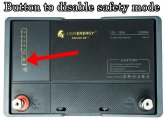I have tested the Lion Energy Safari LiFePO4 batteries on 3 systems since receiving my set and the initial inverter draw for charging up the capacitors loves to trigger the OCPD on the battery, putting the batteries into "safety mode". And getting these batteries out of the safety mode is a pain in the butt! I had to figure it out with trial and error:
Then I have to disconnect the batteries and inverter, press the buttons repeatedly till it goes out of safety mode (which can take 5 tries at times), then wire everything up again. Big pain in the butt!
There is obviously a work around, but it is not very beginner friendly. You can use a resistor to charge up the inverters capacitors, then connect inverter, and the batteries will not be in safety mode...
But I connect lots of these drop in lithium batteries to inverters and they usually have a 1/2 second OCPD to handle surges. Lion energy batteries are the only ones that constantly go into safety mode. I never have this problem with battle borns/valence/ruixu/DIY bms lifepo4's. Only lion safari.
I actually like these batteries. They are small and work well. They did falsely advertise the capacity when first released, but it is a decent battery. Once it is hooked up, it will not go into safety mode at all. I have pushed the batteries for months now, and they work well. You can learn more about them by clicking here if you want


- Press the power button on the top of the battery (only button on the battery) for less than a second, and wait till the SOC battery capacity LED lights turn on.
- Press and hold down the button a second time until the battery capacity lights turn OFF.
- Test voltage of battery with a volt meter. You will know the battery is out of the "safety mode" when you have a voltage of 10-14.4 volts.
Then I have to disconnect the batteries and inverter, press the buttons repeatedly till it goes out of safety mode (which can take 5 tries at times), then wire everything up again. Big pain in the butt!
There is obviously a work around, but it is not very beginner friendly. You can use a resistor to charge up the inverters capacitors, then connect inverter, and the batteries will not be in safety mode...
But I connect lots of these drop in lithium batteries to inverters and they usually have a 1/2 second OCPD to handle surges. Lion energy batteries are the only ones that constantly go into safety mode. I never have this problem with battle borns/valence/ruixu/DIY bms lifepo4's. Only lion safari.
I actually like these batteries. They are small and work well. They did falsely advertise the capacity when first released, but it is a decent battery. Once it is hooked up, it will not go into safety mode at all. I have pushed the batteries for months now, and they work well. You can learn more about them by clicking here if you want





